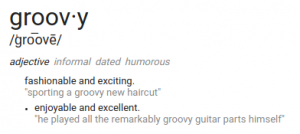Groovy
What is groovier than using the word groovy? Answer: Being able to use tech tools to realize the relative usage of the word “groovy” throughout time and thus conclude that perhaps your smooth colloquialisms might not be so smooth or hip after all. Good news: There is an abundance of alternative adjectives; maybe with some more research you can identify your optimal adjective of choice.
Which brings us to the reason for thinking about word optimization after all – as a slightly more creative method of learning about rates of change, critical points, and optimization in a Calculus class. I’ve designed a lesson that involves students researching word usage to apply the information they will have learned just prior.
After this lesson, students will be able to:
- Identify on which intervals a function is increasing or decreasing.
- Identify whether slope over an interval is increasing or decreasing at an increasing rate (accelerating) or a decreasing rate (decelerating).
- Label critical points and make conjectures about the cause of these points.
- Identify local and global maxima and minima (ie. extrema).
- Apply the Extreme Values Theorem to a graph and explain why, when the conditions of the theorem are satisfied, it assures that the given point is a global maximum or minimum.
Tech Tool to be Used for the Activity – Google Ngram Viewer
Basically, students will use Google Ngram to look up word usage over time and select a few of the resulting graphs to analyze to practice applying what they will have just learned about the topic in a fun way.
For example, students might look up the word “groovy” – yes, I said it again… I’m just helping the search rankings for this poor antiquated word to go up a tiny percentage (I should know better than this) – and the following result will appear:
I particularly like this example because of its graphical qualities – it has a clear increase and decrease and is not very choppy.
Once students have found a “nice” graph, they will then identify a given list of qualities such as maxima, minima, extrema, signs of the slope (derivative) within intervals, and signs of the derivative of the derivative (acceleration) within intervals.
Next, in order to connect this activity to real life, I will ask students to make predictions about why a word gained or lost popularity over a given time period. To make an informed prediction, they might research relevant events that occurred in the given time period and how this might then have affected common word usage. In essence, I want them to realize that graphs tell stories and that math is a tool that we can also use to communicate, illustrate, and explain these stories.
Featured Image : Teresa Boardman


